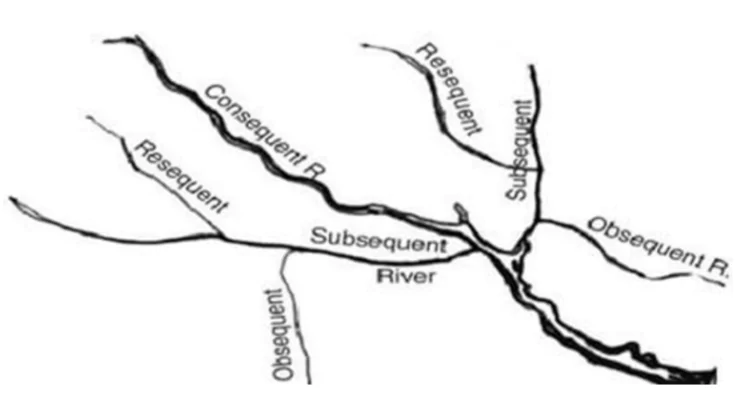Understanding drainage systems is essential for comprehending how water flows through an area. From the vast Amazon Basin to the smallest rivulets, drainage systems shape the landscape. Factors like surface nature and geological structures dictate their patterns, leading to two main categories: sequent and insequent streams.
Drainage Systems: Terminologies, Features, and Factors
Basic Terminologies Used in Drainage System
- Drainage: The term drainage describes the river system of an area
- Drainage Basin: The area drained by a single river system is called a drainage basin.
- World’s largest drainage basin is of the Amazon River.
- River System: A river along with its tributaries may be called a river system.
- Catchment area: A river drains the water collected from a specific area, which is called its ‘catchment area’.
- Watershed: The boundary line separating one drainage basin from the other is known as the watershed.
- The catchments of large rivers are called river basins while those of small rivulets and rills are often referred to as watersheds.
- Regime: pattern of flow of water in a river channel over a year.
- Perennial: A stream or a river that flows continuously through its river bed for a year is known as a perennial river. They have water in their river bed for the whole year.
- Gorge: A canyon, or chasm, is a deep cleft between escarpments or cliffs resulting from weathering and the erosive activity of a river over geologic time scales. Rivers have a natural tendency to cut through underlying surfaces, eventually wearing away rock layers as sediments are removed downstream.
- Antecedent river: The rivers that existed before the upheaval of the Himalayas are known as the antecedent rivers and cut their courses southward by building gorges in the mountains.
Enroll now for UPSC Online Course
Factors Influencing Drainage Systems
- The drainage system of a region is determined and controlled by two main factors
- Nature of initial surface and slope
- Geological structure
- Example: folds, faults, joints etc.).
Classification of Drainage Systems
- Drainage systems are divided into two categories on the basis of the adjustment of the streams to the initial surface and geological structures
- Sequent Streams: follow the regional slope and are well-adjusted to geological structures. \
- Example: Consequent, Subsequent, Obsequent and Resequent streams
- Insequent streams do not follow the regional slope and are not adjusted to geological structures.
- Example: Antecedent and Superimposed streams.
Major Drainage Systems
(A) Sequent Drainage Systems
- Consequent Streams: are the first streams to appear in a particular region. These follow the regional slope; also called dip streams.
- Master Consequent: The longest stream of consequent streams.
- Example: Yamuna and the Ganga are the master consequents.
- Lateral Sonsequent Streams: generally join the master consequent.
 Subsequent Streams: originate after the master consequent stream and follow the axis of the anticlines or ridges and the strikes of beds.
Subsequent Streams: originate after the master consequent stream and follow the axis of the anticlines or ridges and the strikes of beds.-
- Example: Asan River (tributary of Yamuna) and Song river (tributary of Ganga) are examples of subsequent streams.
- Obsequent Streams: flow in opposite direction to master consequent; follow the slopes of the ranges.
- Resequent Streams: are tributary streams flowing in the direction of the master consequents.
- They originated later than the master consequent.
(B) Insequent Drainage Systems
- Antecedent Drainage systems: originated prior to the upliftment of upland or mountains across which they have maintained their present courses through continuous downcutting of their valleys.
- Example: Major Himalayan rivers like Indus, Sutlej, Ganga, Ghaghra, Kali, Gandak, Kosi and Brahmaputra.
- Superimposed Drainage Systems: These are not adjusted to regional geological structures and slopes.
- It is formed when the nature and characteristics of the valleys and flow direction of a stream developed on the upper geological formation and structure are superimposed on the lower geological formation of entirely different characteristics.
- Example: In the Deccan trap (lava) region of Peninsular India many rivers are superimposed because a new drainage system was evolved on the new surface formed due to the cooling and solidification of lavas erupted during the late Cretaceous periods and these rivers were superimposed on the lower formation after the removal of lava covers.
Conclusion
Drainage systems are important components of Earth’s geography, shaping landscapes and ecosystems. Whether it’s consequent streams following regional slopes or antecedent rivers maintaining their courses through mountain uplifts, each system tells a story of geological history and environmental adaptation. By understanding these systems, we gain insight into the dynamic forces that shape our planet’s surface.
![]() May 4, 2024
May 4, 2024
![]() 3657
3657
![]() 0
0
 Subsequent Streams: originate after the master consequent stream and follow the axis of the anticlines or ridges and the strikes of beds.
Subsequent Streams: originate after the master consequent stream and follow the axis of the anticlines or ridges and the strikes of beds.